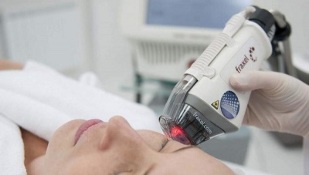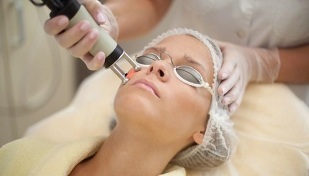
The main causes of skin aging are the deterioration of metabolic function and cell growth, as well as the slow removal of toxins and toxins and a decrease in the supply of nutrients to the cell structure. Thanks to laboratory studies, it is known that this is a reversible process, i. e. there is always the possibility of activating cell activity. Scientists have found that after thermal exposure to a laser, one part of the cell in the dermis is activated, and the other part dies. As a rule, dead cells die from living cells that have no potential for further recovery.
In the process of death of weak cells, the space between empty cells is controlled by stronger cells. The thermal effects that appear after laser treatment activate cell activity, further cell renewal and growth. The quality and speed of cellular repair depends on the diameter of the laser beam. The thickness should not be more than 200 microns, then a healthy and youthful layer of skin will begin to form in the treated area.
For this reason, laser rejuvenation techniques have been improved with the introduction of fractional thermolysis. In this process, the laser beam is divided into many microscopic rays, creating a trace effect structure on the treatment area. The innovative value of this technology lies in the fact that lasers work in the local area, preserving intact skin areas - they accelerate skin regrowth and healing.
Fractional thermolysis varieties
Fractional laser rejuvenation has been successfully used to tighten and tighten the skin in one of two possible ways. They differ in the characteristics of the laser action, the depth of its penetration and the effect on the specific area.
The first method of action - fractional phototrolysis - affects the upper epidermal cells, literally evaporating them. In other words, with this method, only the top layer of skin is exposed.
The second treatment method affects the lower layers of the epidermis and the skin, leaving the upper layers of the skin intact. In both cases, the laser beam has a local effect. Cellular programming zones are preserved around the treated area, which forms the potential for further skin regrowth. In other words, heat shock activates new cell growth and metabolic processes in the cell.The first method of fractional phototrolysis removes the superficial microscopic area of skin cells, tightening the treated area in a short time, so that the results after the procedure can be seen immediately. It smoothes superficial wrinkles and is therefore considered appropriate to get rid of the first signs of age-related skin changes.
The second method of laser effect is suitable for solving deep problems in the skin, when the aging process is already irreversible. This method is a kind of "heavy artillery" laser rejuvenation. Acting on the inner layer of the epidermis and dermis, the laser triggers metabolic processes, forms a new membrane skeleton, activates collagen production, makes the skin look younger and regenerates from within.
It has been proven that the maximum efficiency of fractional phototrolysis is achieved through the use of a combination of two exposure methods. In this case, the skin will have a double effect - outside and inside, which gives a long-term effect on skin rejuvenation. Similar techniques are used by a large number of modern medical institutions that have modern laser equipment.
Procedural efficiency
You can ensure that after laser rejuvenation your skin fraction becomes even, smooth and radiant after the first procedure. Within a week, the oval of the face will feel tight, wrinkles will smooth out, and the skin will be evenly distributed. To consolidate and expand the results, the procedure will be required at intervals of one month.
With the rejuvenation of combined fractions, the effect of youthful skin can be achieved faster and last longer, up to 2-3 years. Of course, the outcome depends a lot on the lifestyle of each patient. Rejection of bad habits, preventive facial care, healthy lifestyle, proper and adequate sleep helps prolong skin rejuvenation and prevents the aging and withering process.
The undoubted advantage of the procedure is its pain. Specialists use surface anesthesia, so during the procedure, the patient feels only a slight tingling sensation in the affected area.
Procedure progress

The undoubted advantage of the procedure is its pain. Specialists use surface anesthesia, therefore, during the procedure, the patient feels only a slight tingling sensation in the affected area. Anesthetics are used shortly before the start of the session, lasting up to an hour - all depending on the surface area of the treatment. After the procedure, the specialist advises the client on the necessary skin care, treating it with a special medical product.
Immediately after the procedure, the skin does not need additional care. It takes a little over a week to get back to the rhythm of your normal life, while recovery after surgery requires harder and longer.
For the first two days, the face will be swollen, after which it will be a little red. After 4-7 days, the dead cells will begin to cleanse, appearing fresh and youthful skin.
Instructions for procedure
If there is any doubt about the effectiveness of fractional laser rejuvenation, then it is necessary to visit the procedure to start it according to the instructions, which are many:
- Acne.
- Pigmentation.
- Spider veins, stretch marks and scars.
- Enlarged pores.
- Wrinkles, crow's feet around the eyes.
- sagging, withered and loose skin.
Contraindications to the procedure
Like any salon procedure, fractional rejuvenation has a number of contraindications:
- Benign and malignant growth in the treatment area.
- Cancer and persistent chemotherapy
- Dermatosis and photodermatoses, in the procedure area.
- Herpes infection in a month.
- Acute infectious infections, lack of immunity.
- Chronic diseases such as bleeding disorders, diabetes mellitus, thromboembolic disease.
- Psoriasis and hypertension.
- History of keloid or vitiligo scars, vitiligo or keloid family history.
- Fresh plants, recent tanning tour.
- Pregnancy and breastfeeding period.
- Retinoid use in the last six months.
Combination of fractional rejuvenation with other procedures
This procedure is always performed only after consulting a beautician. With obvious age-related changes, the laser surface of the skin will provide maximum efficiency, rather than fractional rejuvenation methods. In some cases, it may not be possible without surgical manipulation, such as facelift endoscopy, blepharoplasty or thread insertion for tightening. Even so, laser rejuvenation will help maintain and improve the effectiveness of the procedure. This will complement their results and improve the customer's appearance.
Laser rejuvenation methods are perfectly combined with procedures such as mesotherapy and plasma lifting, as well as biorevitalization based on hyaluronic acid.





































